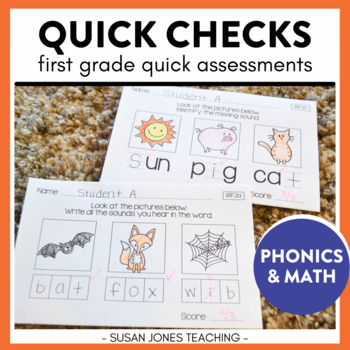Common Core Assessments for 1st Grade: Quick Checks
- PDF
What educators are saying
Description
Quick, Common Core assessments for 1st grade! Included in this unit are short, half page assessments for all the phonics and math standards in 1st grade. The full list is below.
These are great to have in your classroom from the beginning of the year to help track your students' progress!
The Kindergarten version:
Quick Check Common Core Assessments for Kindergarten
***
In my classroom, I like to collect data!
I like to do this without making my students feel like they are just taking tests all the time. In order to help me assess my students and save time, I created these “quick checks.” Each of these assessments are no more than 3 questions long and they all align directly to a 1st grade Common Core Standard.
I give my students these quick checks at different times throughout the year. Before teaching a concept/standard I will give a quick-check as a pre-assessment. After teaching the concept, I will give the same quick-check as a post-assessment.
For my struggling students, I also use these quick-checks to re-assess as needed throughout the year.
I find that these quick assessments are short, but also precise! They let me check in on my students’ progress without taking up too much time! It’s a win-win for me and my students!
In this unit:
- How I use these checklists and quick-checks in my own classroom
- Mastery checklists to record scores for each student and each standard
- Progress checks: more in-depth recording sheets for each student and each standard
- Quick check assessments for each of the following Common Core Standards:
Phonics:
1.RF.2a: Distinguish long from short vowel sounds in spoken single-syllable words.
1.RF.2b: Orally produce single-syllable words by blending sounds (phonemes), including consonant blends.
1.RF.2c: Isolate and pronounce initial, medial vowel, and final sounds (phonemes) in spoken single-syllable words.
1.RF.2d: Segment spoken single-syllable words into their complete sequence of individual sounds (phonemes).
1.RF.3a: Know the spelling-sound correspondences for common consonant digraphs.
1.RF.3b: Decode regularly spelled one-syllable words.
1.RF.3c: Know final -e and common vowel team conventions for representing long vowel sounds.
1.RF.3d: Use knowledge that every syllable must have a vowel sound to determine the number of syllables in a printed word.
1.RF.3e: Decode two-syllable words following basic patterns by breaking the words into syllables.
1.RF.3f: Read words with inflectional endings.
1.RF.3g: Recognize and read grade-appropriate irregularly spelled words.
Math:
1.OA.1: Use addition and subtraction within 20 to solve word problems.
1.OA.2: Solve word problems that call for addition of three whole numbers whose sum is less than or equal to 20.
1.OA.3: Apply properties of operations as strategies to add and subtract.
1.OA.4: Understand subtraction as an unknown-addend problem.
1.OA.5: Relate counting to addition and subtraction.
1.OA.6: Add and subtract within 20, demonstrating fluency for addition and subtraction within 10.
1.OA.7: Understand the meaning of the equal sign, and determine if equations involving addition and subtraction are true or false.
1.OA.8: Determine the unknown whole number in an addition or subtraction equation relating three whole numbers.
1.NBT.1: Count to 120, starting at any number less than 120.
1.NBT.2: Understand that the two digits of a two-digit number represent amounts of tens and ones.
1.NBT.3: Compare two two-digit numbers based on meanings of the tens and ones digits, recording the results of comparisons with the symbols >, =, and <.
1.NBT.4: Add within 100.
1.NBT.5: Given a two-digit number, mentally find 10 more or 10 less than the number.
1.NBT.6: Subtract multiples of 10 in the range 10-90 from multiples of 10 in the range 10-90.
1.MD.1: Order three objects by length.
1.MD.2: Express the length of an object as a whole number of length unit.
1.MD.3: Tell and write time in hours and half-hours using analog and digital clocks.
1.MD.4: Organize, represent, and interpret data with up to three categories; ask and answer questions about the total number of data points.
1.G.1: Distinguish between defining attributes versus non-defining attributes.
1.G.2: Compose two-dimensional shapes or three-dimensional shapes.
1.G.3: Partition circles and rectangles into two and four equal shares, describe the shares using the words halves, fourths, and quarters.
Download the preview to get a closer look!
Susan Jones





